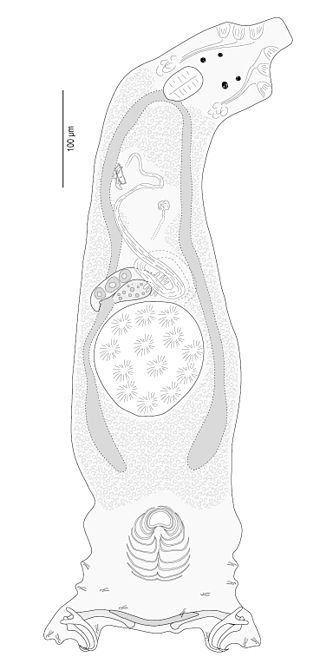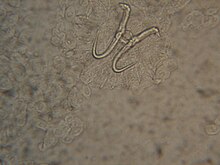
Gyrodactylus is a genus of parasitic flatworms in the family Gyrodactylidae.

Clamps are the main attachment structure of the Polyopisthocotylean monogeneans.
These ectoparasitic worms have a variable number of clamps on their haptor ; each clamp is attached to the host fish, generally to its gill. Clamps include sclerotised elements, called the sclerites, and muscles. The structure of clamps varies according to the groups within the Polyopisthocotylean monogeneans; microcotylids have relatively simple clamps, whereas gastrocotylids have more complex clamps.

The Diplectanidae are a family of monopisthocotylean monogeneans. They are all parasitic on the gills of fish. Diplectanids are small animals, generally around 1 mm in length. As parasites, they can be extremely numerous, up to several thousand on an individual fish.
Alexandr Vladimirovich Gussev, sometimes spelled Gusev in the literature, was a Russian helminthologist specialist of monogeneans.
Calydiscoides is a genus of monopisthocotylean monogeneans, included in the family Diplectanidae.
Hexabothriidae is a family of monogenean parasites. The family name was proposed by Emmett W. Price in 1942. The family includes 14-16 genera according to authors and about 60 species; all are parasitic on the gills of chondrichthyan fishes.

Lamellodiscus is a genus of monopisthocotylean monogeneans in the family Diplectanidae; all species of Lamellodiscus are small worms, parasitic on the gills of teleost fish.
Citharodactylus is a genus of monogeneans in the family Gyrodactylidae. It consists of one species, Citharodactylus gagei Přikrylová, Shinn & Paladini, 2017.
Gyrodactyloides is a genus of monogeneans in the family Gyrodactylidae.
Laminiscus is a genus of monogeneans in the family Gyrodactylidae. It consists of one species, Laminiscus gussevi . Laminiscus is a marine parasite, using its haptor to attach itself to a marine fish host. Its haptor consists of no dorsal bar, additional internal support plates, hamuli with distinct dorsal and ventral roots, and marginal hook sickles with poorly developed heels and short handles.
Polyclithrum is a genus of monogeneans in the family Gyrodactylidae.
Fundulotrema is a genus of monogeneans in the family Gyrodactylidae.
Paragyrodactylus is a genus of monogeneans in the family Gyrodactylidae.

Ancyrocephalidae is a family of monogenean flatworms. The family is considered as a "temporary name" in WorMS but includes a large number of genera and species.
Anchoradiscus is a genus of monogeneans belonging to the family Ancyrocephalidae. All members of the genus are parasitic on North American centrachid fish.
Delane C. Kritsky is an American parasitologist who specialised on the Monogenea, a class of parasitic flatworms which are important ectoparasites of fishes. His research was mainly in the fields of taxonomy, faunistics, and phylogeny of the Monogenea.
Rhabdosynochus is a genus of monopisthocotylean monogeneans, belonging to the family Diplectanidae.
Protolamellodiscus is a genus of monopisthocotylean monogeneans in the family Diplectanidae. All species of Protolamellodiscus are parasites of marine perciform fishes of the families Lethrinidae, Nemipteridae, Serranidae and Sparidae.

Microcotylinae is a subfamily within family Microcotylidae and class Monogenea. This subfamily was created by Taschenberg in 1879.
Bivagina is a genus of monogeneans. As all Monogenea, species in the genus are ectoparasites that affect their host by attaching themselves as larvae on the gills of fish and grow into adult stage. This larval stage is called oncomiracidium, and is characterized as free swimming and ciliated.






